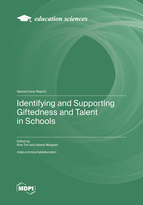Identifying and Supporting Giftedness and Talent in Schools
A special issue of Education Sciences (ISSN 2227-7102).
Deadline for manuscript submissions: closed (31 July 2023) | Viewed by 35431
Special Issue Editors
Interests: gifted education; talent development; teacher education; cross-cultural studies
Special Issues, Collections and Topics in MDPI journals
Special Issue Information
Dear Colleagues,
In this Special Issue, we invite contributors to address the current challenges and opportunities in identifying and supporting gifted students in schools and early childhood education (ECE) settings. We take a holistic approach to education and invite papers that focus on cognitive, emotional, social, and moral domains concerning giftedness and talents. Countries differ in their educational provisions for gifted students, and we need to learn from each other on how to best meet the needs of gifted students. We welcome papers from different parts of the world to present their practices and approaches in teaching gifted students. We also need more research regarding teachers’ values, beliefs, and attitudes that influence their pedagogical decisions with high-achieving students and talent development. Inclusive education presents challenges on how to identify different gifts and talents and how to meet the needs of different learners in the same classroom. We welcome papers regarding inclusive education and the ways teachers can differentiate teaching in different subjects for gifted students or in transdisciplinary, holistic education. We also invite papers that consider acceleration and grouping that help gifted students to advance faster in their learning. Case studies concerning special programs and enrichment opportunities are also very suitable for the scope of this Special Issue.
We invite contributors to address the current challenges and opportunities in identifying and supporting gifted students in school and ECE in international contexts. The articles can be theoretical or empirical as long as they provide research-based knowledge to improve the teaching of gifted students globally.
We look forward to receiving your contributions.
Prof. Dr. Kirsi Tirri
Prof. Dr. Valerie Margrain
Guest Editors
Manuscript Submission Information
Manuscripts should be submitted online at www.mdpi.com by registering and logging in to this website. Once you are registered, click here to go to the submission form. Manuscripts can be submitted until the deadline. All submissions that pass pre-check are peer-reviewed. Accepted papers will be published continuously in the journal (as soon as accepted) and will be listed together on the special issue website. Research articles, review articles as well as short communications are invited. For planned papers, a title and short abstract (about 100 words) can be sent to the Editorial Office for announcement on this website.
Submitted manuscripts should not have been published previously, nor be under consideration for publication elsewhere (except conference proceedings papers). All manuscripts are thoroughly refereed through a double-blind peer-review process. A guide for authors and other relevant information for submission of manuscripts is available on the Instructions for Authors page. Education Sciences is an international peer-reviewed open access monthly journal published by MDPI.
Please visit the Instructions for Authors page before submitting a manuscript. The Article Processing Charge (APC) for publication in this open access journal is 1800 CHF (Swiss Francs). Submitted papers should be well formatted and use good English. Authors may use MDPI's English editing service prior to publication or during author revisions.
Keywords
- gifted education
- talent development
- school education
- inclusive education
- differentiation
- international contexts







